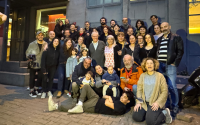Published on Thursday, August 26, 2004 by USA Today
New York's Central Park has long been the logical place for mass gatherings, with its sprawling Great Lawn and, well, central location. In 1991, singer Paul Simon drew 750,000 there. In 1995, Pope John Paul II celebrated a mass that drew more than 130,000. And in 1997, country singer Garth Brooks played to a crowd of 250,000.
But political assemblies on the eve of the Republican National Convention appear to be taboo. This week, city officials persuaded a federal judge to keep the park off limits Saturday to a protest rally by 75,000 people jointly sponsored by an Arab-American coalition and an anti-war group. And a state judge sided with the city Wednesday in barring a 250,000-person rally in the park Sunday to protest President Bush's policies. She said sponsors were reneging on an earlier agreement to hold the rally elsewhere.
Believe it or not, one of the city's chief concerns is that the protesters will tear up the Great Lawn, refurbished in 1997 for more than $18 million. In fact, the judge who banned Saturday's protest cited the organizers' failure to provide adequate plans to prevent damage to the grass.
Worries about trampling on the city's grass are a weak excuse for treading upon Americans' First Amendment right to assemble to protest their government.
Such misplaced concerns aren't limited to Republicans. At July's Democratic convention in Boston, protesters were confined to a fenced-off area that resembled a cage.
In New York, the city originally tried to banish major protests to Queens, miles from the convention. When that idea went over badly, officials insisted that Sunday's rally take place on a blocked-off section of a highway along the Hudson River. Sponsors said they would cancel the rally if they couldn't use the park, raising the specter of thousands of frustrated marchers surging around Manhattan with no place to go.
That's why New York would be wise to make the park available. Mass rallies in Washington are usually held on the National Mall — despite the wear and tear on its grass — to give protesters a place to voice their grievances without spilling into the streets.
Last week, Mayor Michael Bloomberg made a big deal of offering discounts on food, hotels and various entertainment options, even the Museum of Sex, to protesters who would agree to play nice — and wear buttons identifying themselves as "peaceful political activists." That was the day after he showed his disdain for the rights of Bush critics, saying that if people "start to abuse our privileges, then we lose them."
But even in a war on terror, political protest is not a "privilege." It's a basic right.
"The right of the people peaceably to assemble, and to petition the government for a redress of grievances," is part of the Bill of Rights, which the Founders drafted more than two centuries ago to persuade the states to ratify the Constitution.
If Bloomberg has forgotten that, regrettably, he has plenty of company. In a nationwide poll conducted earlier this year for the Freedom Forum's First Amendment Center and American Journalism Review, only 10% of respondents could name the right of assembly and free association as one of those guaranteed by the First Amendment.
After the oppression of British colonial rule, those were among the rights the Revolution was fought for. They're still worth defending. Protecting municipal grass is a thin excuse for mowing down those rights.
© Copyright 2004 USA TODAY






